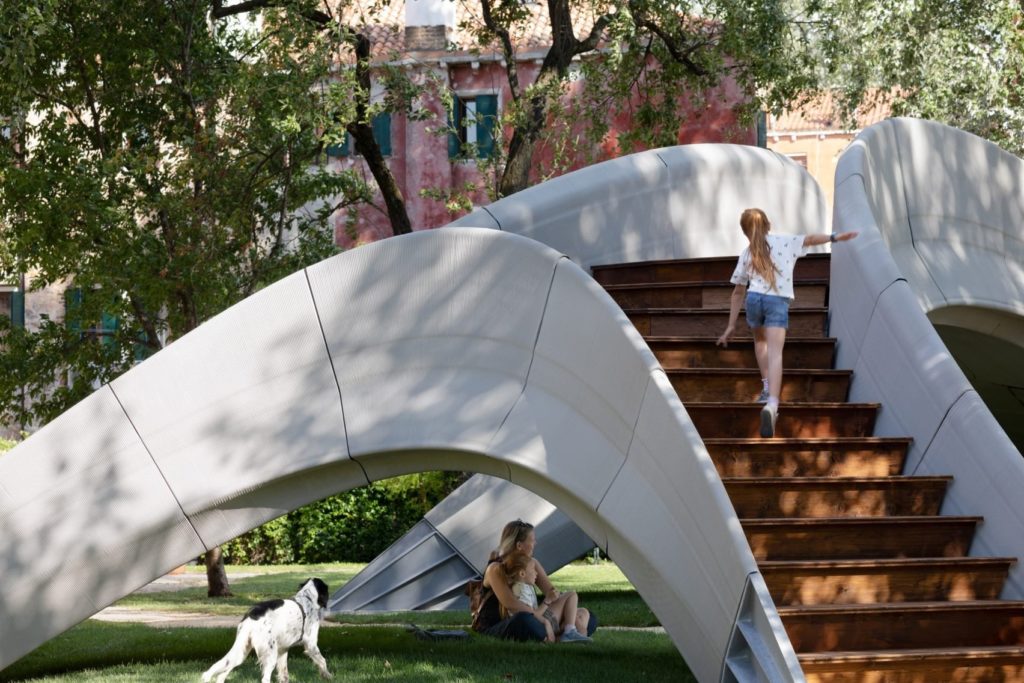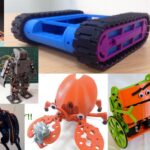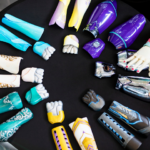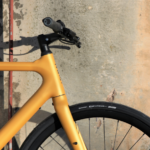

“Bridge” is a word that frequently comes to mind when you think about 3D printing. It’s a bridge technology, one that could help humanity make the transition from the fossil fuels era to the era of renewables; it can be used to bridge the gap in supply-chain disruption scenarios. Also, you can use it to make bridges!
Children running under the Striatus circular bridge (image c/o Dezeen)
Swiss company Holcim, the building materials division of Holcim Group (previously LafargeHolcim), is currently showcasing in Venice, Italy a circular, unreinforced bridge that technicians printed with a six-axis robotic arm. Holcim has named the modular bridge product Striatus, and used a custom-made proprietary “ink” to manufacture it.
The Striatus bridge’s organic shape accentuates its verdant surroundings (image c/o Dezeen)
While Holcim is the biggest name involved in the project, it was a collaborative effort between Block Research Group at Swiss university ETH Zurich and the Computation and Design Group at Zaha Hadid Architects, who built the bridge. The structure measures 16 meters long and is comprised of 53 hollow blocks held in place by compression alone. This means that it can be disassembled, reassembled, and, if need be, recycled.

This is a much more upbeat story than some of the other recent headlines Holcim Group has been making, largely involving charges of crimes against humanity (!) brought against it in France’s highest court, related to the actions of the French company Lafarge in Syria between 2011-2014, before it merged with Holcim in 2015:
“The group halted its Jalabiya plant in northern Syria – almost 100 km (63 miles) from Raqqa – in 2014 when the factory came under attack from militants. But it continued to operate in the area and maintain local staff after the country was beset by conflict in 2011 and as surrounding areas gradually came under the control of armed groups such as Islamic State.” – Reuters
Coupled with the company’s rebranding, is it possible the Striatus bridge project could be an attempt to deflect away from the negative publicity it’s been receiving? In a recent post, I mentioned the great, unsung environmental conundrum of concrete, a commodity responsible for an estimated 4-8 percent of global CO2 emissions, but which garners far less attention than things like automobiles or industrialized meat production.
According to Holcim CEO Jan Jenisch, “3D concrete printing can reduce up to 70 per cent of materials with no compromise on aesthetics or performance.” This seems a bit hyperbolic according to the industry’s current state of research on the topic, but life cycle assessment studies on 3D printing are of course still in early stages overall, and Jenisch certainly appears correct that performance-wise, you don’t seem to lose anything by using 3D printing.
The mixture of tradition with the wooden staircase and futurism with the swooping curves of the bridge’s outer frame is becoming characteristic of the 3D printing aesthetic (image c/o Dezeen)
More interesting than the particulars of the bridge itself, however, is the very sophisticated example of “greenwashing” going on here. Greenwashing is usually used to refer to the practice undertaken by corporations or industries as a whole which make an especially detrimental impact on the environment, whereby they highlight specific, relatively eco-friendly projects they’re working on to garner public relations’ goodwill. In this case, if this is indeed what Holcim is engaged in, an eco-friendly, human interest story is seemingly being utilized to divert public notice away from a scandal that doesn’t have much to do with the environment, at all.
This isn’t to say that the Striatus isn’t a fine bridge! It’s a masterpiece of engineering. But if 3D printing’s potential to augment or even drive a society-wide shift to sustainability is just used for the same old PR games we’ve all become so accustomed to, the technology will end up losing the goodwill it has accumulated before it even gets a chance to deploy it on a large scale.
When it comes to 3D real estate visualization in the USA, our service provides the perfect solution for bringing property listings to life. Through our platform, you can easily access cutting-edge 3D renderings that showcase your real estate projects in a way that attracts potential buyers and investors. Whether it's residential, commercial, or mixed-use properties, our team of experts uses advanced technology to create immersive visualizations that highlight the best features of your property, making it easier for clients to imagine the space as their own.
Through our website, you can quickly get high-quality 3D real estate visualizations that are tailored to your specific needs. With our help, you'll stand out in the competitive real estate market by offering potential buyers a realistic, interactive view of your property. Our efficient process ensures a fast turnaround time, while our attention to detail guarantees that every aspect of the property is represented accurately, giving you a powerful marketing tool to promote your real estate listings.






